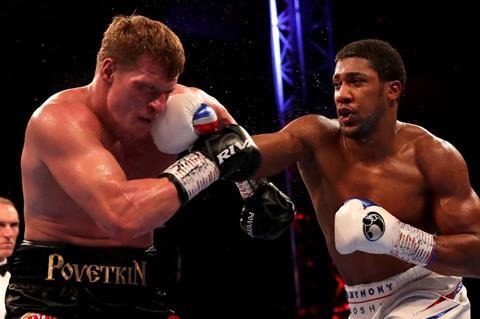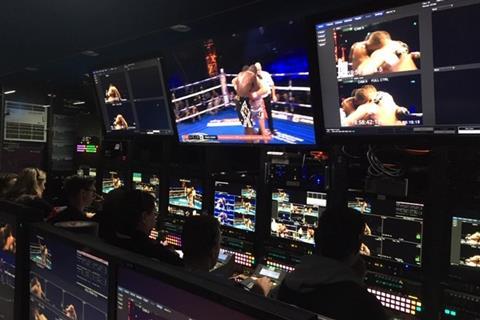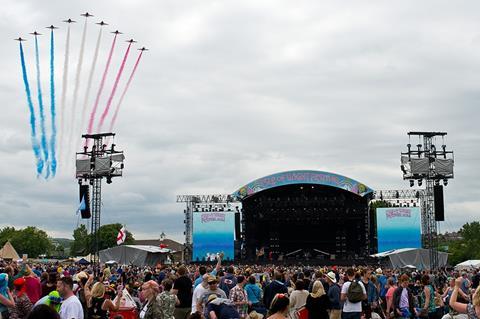Sky is one of a handful of global broadcasters taking a prominent role in evolving the use of Dolby Atmos in live events, Andy Stout reports.
Last month, in one of the biggest boxing matches seen in the UK for several years, Anthony Joshua knocked out Alexander Povetkin at Wembley Stadium to maintain his custodianship of the WBO, WBA and IBF world heavyweight belts.

It took Joshua to a highly impressive record of 22 fights and 22 victories. It was his first though, and the first pay-per-view match ever, to be captured in UHD and Dolby Atmos.
For the Sky team behind the Sky Box Office presentation, it marked the latest stage in a history with Atmos that started with tests in football broadcasts at the beginning of 2017 before being rolled out across its UHD EPL coverage from the start of the 2017/2018 season.
As such, even though the individual members of a production might be coming across it for the first time, there’s an impressive bank of knowledge building up regarding the format.
Nik Taylor-Pugh, was sound supervisor on that night, and it was his first Atmos broadcast. “The one difficulty with the Joshua fight was that it was chucking it down with rain at Wembley,” he says.
“At the beginning of the evening, that put something of a dampener on the atmosphere, so it was quite difficult at the beginning to notice much going on in the heights. It became much more immersive as the atmosphere built towards the main event.”
Dolby Atmos effectively expands upon surround sound by adding an overhead, and thus third, dimension, typically leading to a 5.1.4 audio set up with the last four speakers either being ceiling mounted or upward firing.
In its home theatre configuration, which is distinct from cinema implementations, it can support up to 24.1.10 channels, though in practice it is more typically Atmos-capable soundbars that are really driving its domestic growth.
The fact that it builds upon 5.1 has meant that technically some of the aspects of its production have been fairly easy to accommodate for broadcasters. Sky, for example, already uses Soundfield microphones to capture all of its sporting events in 5.1.
“In most things we do we haven’t added any microphones, so the microphone plot stays the same,” explains Technical Specialist, Robin Broomfield.
“We use the Soundfield mics that we already use and simply add some of the elements from those to give us the height and that crowd feeling. We also put some other objects in the height such as the PA.”
Commentary meanwhile tends to get rendered as an object and kept in the centre.
While it is constantly tweaking the process, Sky’s football audio set up for Atmos is now well understood, and a similar set-up is going to be used for the Autumn International rugby next month.

Boxing, though, is slightly more complex due to the different audio elements, such as walk-on sequences and the close attention being paid to the seconds in the corners.
“With the boxing we put the corner poles into the heights, while the commentary was placed as an object in the centre,” says Taylor-Pugh.
“The idea there was that when commentary was speaking over a close-up shot for the team in the corner talking, you can still hear what they’re saying and the commentary isn’t taking over. When you perceive audio in a different plane from being in front of you, you enable it to be audible rather than being drowned out.”
It is, however, a learning experience. “Putting the music walk-ons in the heights works well,” he continues, “but the MC didn’t benefit from it so much, so we’ll put that in the bed more likely next time.”
“At the moment we just feel that a good immersive experience is much better than simply showing off your technology.” Robin Broomfield, Sky
Navigating the heights
There are other things that the team is learning as well. For Taylor-Pugh mixing the sound live, exactly where the heights live on the Calrec consoles that Sky tends to spec with its OB providers is something that he plans to change next time. It is also leading audio in general to have to deal with an increased level of precision.
“If you listen to stuff in stereo if there’s an issue with a quiet microphone you can get away with it because everything’s crammed into the stereo field,” he says. “But if it’s a mic that’s been isolated and sent to the heights, then it’s a lot more noticeable.”
All in all the heights are an unforgiving place. Atmos productions tend to inflate the amount of time spent in audio post, so the job for the crew mixing live is more complex. And not content with just ramping up its use in sports, Sky is also driving its adoption in entertainment as well.
Sing: Ultimate A Cappella, It’s Christmas Live from the Royal Albert Hall, and the Queen’s Speech (the Queen in mono, the choirs in Atmos), were all recorded in the format last year, with a huge amount learned in the process. It’s Christmas Live, for instance, deployed 35 microphones in three rings from low to high
“We found that if you mix something for 5.1 and you use everything, when you start to bring that up into the height you don’t get the same sense of immersion: it all starts to blur into one,” explains Kevin McCue, Senior Manager of Technical Operations at Sky Post Production.
“You want to send things up that are specifically captured for the heights or at the cross point between the 5.1 ring and the high ring, because if you have things that exist in the height and the 5.1 ring at the same time at the same level it doesn’t work.”
“The thing about Atmos is you need to have things moving all the time,” he adds. “As sound goes above your head it starts to mono, so you need things to be different and be slightly moving all the time. If they’re static or the same as on what’s left or right above you the whole image just flattens.”
The complexities of Atmos production are illustrated nicely by an anecdote McCue tells of trying to replicate the channel-based workflow of the live set up for recorded productions. The team spent a month devising a workflow that takes audio off the timeline in ProTools, into a Dolby RMU renderer which produces channel-based 5.1.4 that passes into an ED2 encoder. “It then comes back onto the ProTools timeline to be captured so that we can use the ED2s, before coming off the ProTools timeline into a decoder, which then comes back into our own box so we can monitor that,” says McCue.

There have been other complications too. Sky became the first broadcaster to broadcast a live music festival in Atmos at the Isle of Wight Festival earlier this year, using two specially kitted out audio trucks to broadcast seven hours a day from the festival’s two stages
“The difficulty was the Sound Supervisors were finding it almost impossible to mix in Atmos,” says McCue. “A band walks on stage and has a line check and the sound super probably has the first two minutes of the first song to get a mix together. With the high speakers on they couldn’t do it.
”They’re in quite tight trucks and they put four speakers up over their head, put a load of audience into it, and the speakers immediately fire that down onto these large desks, which refract it, and the whole thing completely confuses their ears.
”So, if you’re going to try and do music in trucks in Atmos, you probably need to be in a 5.1.2 environment where your height speakers sit forwards and are up and out of the way of the mixer.”
“We found that if you mix something for 5.1 and you use everything, when you start to bring that up into the height you don’t get the same sense of immersion: it all starts to blur into one.” Kevin McCue, Sky Post Production
Evolving the workflow
Sky’s set-top-boxes take a 5.1 mix and down convert to stereo, meaning that 5.1 is the default mix from which the Atmos derives. McCue would like to see that reversed and start mixing natively in Atmos, using the render function of the Dolby RMU to generate the 5.1 which can then be sent out to the STBs as usual.
For now though, Atmos is slated for a few new entertainment productions that can’t yet be talked about publicly, the aforementioned international rugby, and some forthcoming darts. The latter is an event with loud walk on sequences and rowdy crowds which is considered to be very similar to boxing, from an audio perspective at least.
From there, it’s all about using those heights to achieve more immersion, and there have been discussions internally about using it to drive audio cues in the same sort of manner that spatial audio works with VR. But Sky’s watchword here, as it often is with the introduction of new technology, is restraint.
“We came into this not knowing what the impact would be and there is a view that if you have this extra dimension you should be using it hard,” says Broomfield. “There is a feeling that things should be moving around in the height, but we’re a bit more conservative.
”At the moment we just feel that a good immersive experience is much better than simply showing off your technology. Rather than starting to put things in that aren’t there, where it goes next is just becoming more immersive and trying to make people genuinely feel like they’re at the venue we’re covering.”
























No comments yet